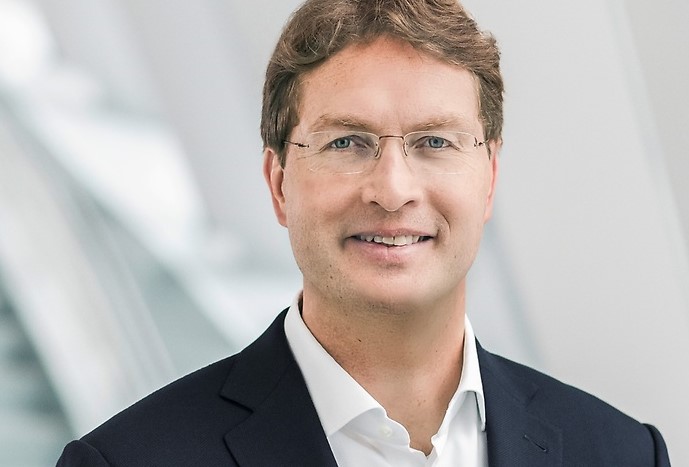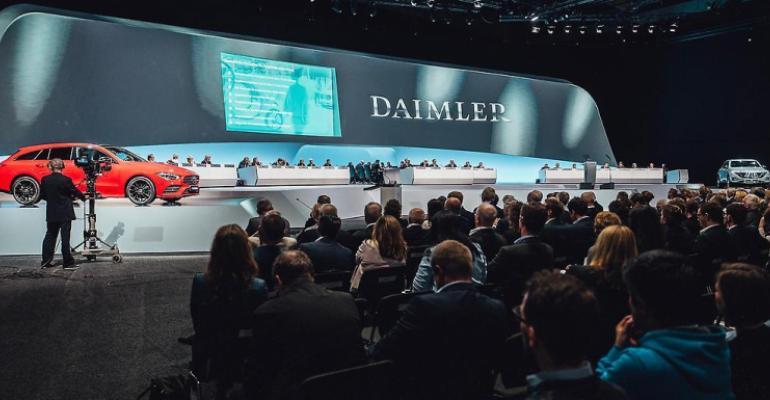BERLIN -- Daimler enters a new era with a new corporate structure, a new leadership team and what it hopes is a strategy that will help it cope with the increased turbulence created by new technology and quickly shifting fortunes that have turned managing an auto company a bit like navigating the rapids of a swiftly flowing river.
The German automaker’s annual meeting here marks the end of the careers of two senior executives, CEO Dieter Zetsche and Chief Financial Officer Bodo Uebber.
Zetsche left his mark on Chrysler Group early in the century, but after becoming CEO and chairman of Daimler’s board of management he pushed for ending Daimler’s merger with the struggling U.S. automaker in 2007 by selling it to private investors. Chrysler filed for bankruptcy two years later and was forced to merge with Fiat under terms of a bailout by the U.S. government.
Daimler’s failed merger with Chrysler remains a sore point with some longtime shareholders, judging from comments during the German automaker’s annual meeting in Berlin.
However, for Daimler’s new leadership headed by Ola Kallenius (below, left), the Daimler Chrysler era is ancient history.
Kallenius, who replaces Zetsche in the dual role as Daimler CEO and head of Mercedes-Benz Cars and shares his enthusiasm for Formula 1 racing, joined the automaker in 1995.
After holding several national and international management positions, he was named to the Daimler management board with responsibility for Mercedes-Benz Cars Marketing and Sales in January 2015. In January 2017, he took over responsibility for Group Research and Mercedes-Benz Cars Development.
In addition, Harold Wilhelm, who was hired away from Airbus last month, replaces Daimler veteran Uebber as CFO. Markus Schaefer, head of Mercedes-Benz manufacturing and procurement, assumes Kallenius’ role as head of R&D. Brita Seeger, chief of sales for Mercedes-Benz Cars, was named to the Daimler management board.
Shareholders also voted by a large majority to reorganize the Daimler Group, clearing the way for the automaker to separate its car and van business from its truck and bus business into two legally independent entities.
The operational launch of the new company structure, which requires offering job guarantees to thousands of white-collar workers, is targeted for Nov. 1. From that date onward, Mercedes-Benz AG will be responsible for the current Mercedes-Benz Cars and Mercedes-Benz Vans divisions, while Daimler Trucks and Daimler Buses will be joined as Daimler Truck AG. Daimler Financial Services AG, already legally independent, will be called Daimler Mobility AG starting in July.
The two new companies, like the current Daimler and Daimler Mobility, will be co-determined German stock corporations. Daimler will become a holding company owning 100% of the stock in the new companies and will not be able to sell the shares for at least two years, according to Daimler officials.
As a publicly listed parent company, Daimler will perform the functions of governance, strategy and control, and will provide group-wide services, says Manfred Bischoff, chairman of the Daimler board of supervisors.
Under the new structure, Daimler wants to give its divisions more entrepreneurial freedom, increase market and customer orientation, and make cooperation easier and faster. By focusing the new companies on their customers, markets and core competencies, new growth and earnings potential can be realized. One advantage of the new structure is that it permits each of the independent companies to enter into both short- and long-term alliances with other companies as the auto industry evolves, Bischoff says.
Zetsche says the automaker will remain focused on building for a sustainable future that will include electric vehicles.
“Daimler has made significant progress in recent years, although we are not satisfied with the latest quarterly results and the share price,” says Zetsche, who became emotional at the beginning of the meeting as he acknowledged a tribute from Bischoff and applause from the 5,000 or so shareholders in attendance.
After recovering its footing in China, where Daimler has its largest factory and its largest R&D center outside Germany, Mercedes-Benz has been the luxury-vehicle sales leader since 2016, the outgoing CEO notes.
“In the commercial-vehicles segment, we were able to further build on our leading position,” Zetsche says. “This offensive was not an end in itself. With it, we have built up the strength we need in order to take on the leading role for the much greater task: the transformation of the automotive industry. To do so, we have initiated the greatest change in our history.
“This transformation is in full swing and it encompasses our products and technologies as well as our business model and corporate culture.”
 Shareholders, however, brought up critical issues facing Daimler such as the continuing fallout from the Dieselgate scandal that has engulfed the German auto industry. Dieselgate already has cost Daimler roughly one-third of a billion dollars – the only estimate offered shareholders by senior executives – and the company remains under investigation both in Germany and the U.S. Other shareholders, including some in their teens, pressed the automaker to do more to fight climate change. “This is not about me,” one shareholder says. “This is about the life of my children and your children.”
Shareholders, however, brought up critical issues facing Daimler such as the continuing fallout from the Dieselgate scandal that has engulfed the German auto industry. Dieselgate already has cost Daimler roughly one-third of a billion dollars – the only estimate offered shareholders by senior executives – and the company remains under investigation both in Germany and the U.S. Other shareholders, including some in their teens, pressed the automaker to do more to fight climate change. “This is not about me,” one shareholder says. “This is about the life of my children and your children.”
Zetsche responds that Daimler is firmly committed to doing what it can to mitigate the effects of climate change.
“The aim is to transform the entire portfolio of new cars into a CO2-neutral range of vehicles by 2039,” he says. “This includes topics such as raw materials and the supply chain, vehicle production, the use phase and recycling concepts. Comparable transformation plans are being developed for commercial vehicles.”
The diesel engine will continue to play a role in the company’s plans for the next decade or more, Zetsche adds.





